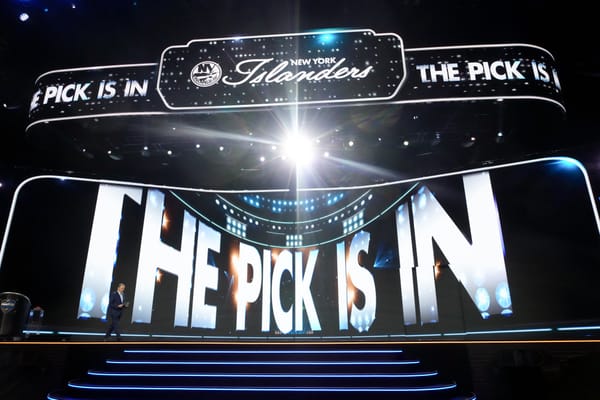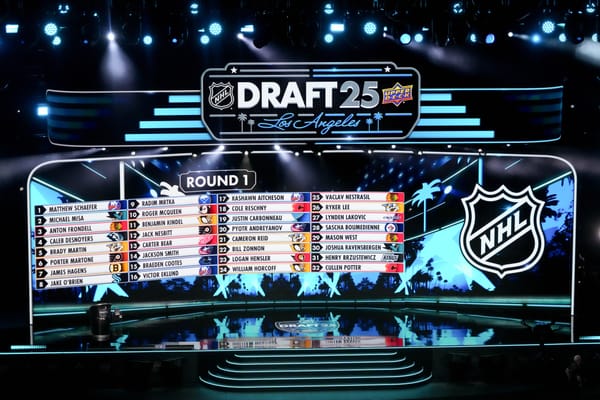NHL Analysis: Understanding the Salary Cap
Our friend Dave over at Blue Seat Blogs put this together, and was nice enough to share it with us. It is a terrific breakdown of how the salary cap works, as well as buyouts, free agency, waivers, arbitration, and everything in between. Best of all, he explains in a way even a dingbat like me can understand. Since the off season is in full swing for us, I think it would be a good idea to start with an education for all of us of how it all works. I guarantee you that by the time you finish reading this you will have a better understanding of how the NHL Salary Cap works.
Understanding the Cap
With the salary-cap era well underway, there are always questions about how the cap works, and that leads to questions on the CBA (Collective Bargaining Agreement). We are no masters of the CBA, but we generally understand the verbiage behind it regarding the salary cap, so let's go through it:
Salary Cap Ceiling: The maximum amount of money a team can spend on player salaries. This number varies from year to year based on the NHL's revenue from two seasons ago. For example, the salary cap for the 2008-2009 season was set based on the NHL revenues from the 2006-2007 season. The NHL is looking at a decreasing cap figure for the 2010-2011 season due to less revenues during the 2008-2009 season.
- No player can earn more than 20% of the salary cap
- The minimum player salary will rise to $525,000 by 2011-2012
- There is a clause in the CBA (Collective Bargaining Agreement) that allows the players to enact a 5% increase on the cap ceiling. This clause was enacted in June 2009, thus preventing a decrease in the salary cap ceiling for the 2009-2010 season.
Salary Cap Floor: Similar to the salary cap ceiling, this is the minimum amount that a team must spend on player salaries. This is more of a formality, but it prevents teams from intentionally tanking the season, and ensures players are paid market value. This number is generally set as $16 million below the cap ceiling.
Salary Cap Hit: The amount of salary cap room that a player takes up. This number is calculated by the average dollar figure of the contract. For example, Markus Naslund signed a two year, $8 million contract. His cap hit for those two years is $4 million, despite the fact that he earned $5 million in the first year of the contract. Weighted contracts have no effect on the cap hit.
- For an explanation on why GMs are giving out such long term deals to free agents, and the affect these contracts have on the cap hit read my post here.
Performance Based Bonuses: Players on entry level contracts, veterans who have played over 400 games, players who sign a one year contract and are over 35 years old, or players who have spent 100+ days on the IR are all eligible for performance based bonuses. These bonuses count against the following seasons cap.
Entry Level Deals: Entry level contracts are capped at $925,000 (by 2011). These contracts vary in length. For those aged 18-21, the entry level contract is for three years, 22-23 are for two years, and 24 are for one year.
- Entry Level Bonuses: Bonuses for entry level contracts are capped at 10% of the players contract. These bonuses count against the cap. For example, Lauri Korpikoski's salary in 2008-2009 was roughly $900,000, but his cap hit was over $1 million because of the signing bonus.
Waivers: When a player is waived (sent to the minors), each of the 29 NHL teams can put in a claim for the player. In the case that more than one team puts in a claim for a waived player, the team with the worst record gets the claim. The player is moved to the claiming team for the full (or, if mid season, pro-rated) salary cap hit. If a player clears waivers, he can be reassigned to the minors, and the salary cap hit is cleared until the player is recalled.
- Waiver Eligibility: Waiver eligibility is actually incredibly complicated, but the guys over at NHLSCap.com have a very detailed explanation of the process. I'm not going to rehash it here, so head over and check it out for a full definition of what exactly the waiver restrictions are. In short, waiver eligibility depends on the age the player signs his first NHL contract, and the number of NHL games played, including playoffs. There's a nice table put together at NHLSCap.
Re-Entry Waivers: When a player clears waivers, and is recalled to the NHL, he must pass through re-entry waivers. Re-entry waivers is similar to regular waivers, however the claiming team can claim the player for 1/2 of the players remaining salary, while the original team picks up the other 1/2. For example, if the Rangers claimed Sean Avery when he was initially waived, they were going to be on the hook for the full $4 million cap hit. They claimed him on re-entry waivers, and thus only are responsible for the $2 million cap hit (Dallas picks up the remaining $2 million). Re-entry waiver eligibility is the same as waiver eligibility, described above.
Over 35 Signings: If a player who, as of June 30 of the upcoming season, is over the age of 35 signs a multi-year deal, the signing team will take a cap hit for each year on the contract, regardless of if the player retires. For example, if Chris Chelios signs a 3 year deal worth $2 million per year, and retires after the first year, the signing team still takes a $2 million cap hit for the remaining years on the contract. However, since Markus Naslund's 35th birthday was after June 30, he was 34 as of June 30, thus his retirement removes his cap hit.
- Waiving a 35+ Signing: In the event that a player signed to a 35+ contract is waived and sent to the minors, the NHL cap hit is reduced by $100,000.
Restricted Free Agents: A player set to become a restricted will become an unrestricted free agent if his current team does not make him a qualifying offer that adheres to the minimum raise policy of the CBA. The deadline to qualify all RFA's is June 29
- Qualifying Offers: A qualifying offer must include the following minimum raises:
- Previous salary < $660,000: 10% increase in salary
- Previous salary < $1,000,000: 5% increase in salary
- Previous salary > $1,000,000: Match previous season's salary
- RFA Ages: A player remains a restricted free agent until his age 27 season. No player can become an unrestricted free agent until he turns 27.
- Compensation for Offer Sheets: If an RFA signs an offer sheet from a different team, the original team is entitled to compensation in the form of draft picks from the next year's draft (All figures are estimates, and change each season):
- Offer sheet < $860,000 annually: No compensation
- Offer sheet between $860,000 - $1.3 million annually: 3rd round pick
- Offer sheet between $1.3 million - $2.6 million annually: 2nd round pick
- Offer sheet between $2.6 million - $4 million annually: 1st and 3rd round pick
- Offer sheet between $4 million - $5.2 million annually: 1st, 2nd, and 3rd round pick
- Offer sheet between $5.2 million - $6.5 million annually: Two 1sts, one 2nd, and one 3rd round pick
- Offer sheet > $6.5 million annually: Four 1st round picks
Arbitration: RFA's that are eligible (see below) can file for arbitration if a contract agreement cannot be met. Players filing for arbitration are protected from offer sheets, as described above. In an arbitration hearing, both sides (player, team) present their case/argument to an impartial third party, who then comes to a decision based on the cases heard. Cases are usually based around stats, tenure with the team, injury history, overall contribution, and a comparable players salary who signed as an RFA (UFA salaries are inadmissible).
- Eligibility: A player is eligible for arbitration if he meets one of the following criteria:
- Players who have four years or more of professional experience under NHL contract. (The exception to this rule is for players who started their pro careers in the 2004-05 lockout season, as that year does not count for determining salary arbitration eligibility).
- Players whose age at signing their first NHL contract plus their number of years of pro experience under NHL contract adds up to 24 or more.
Eligibility is fairly complicated, so let's use Brandon Dubinsky in 2009 as an example. Dubinsky, born in 1986 (22 years old), signed with the Rangers for the 2005-2006 season (played in the AHL). He was 19 when he signed the deal, and has 4 years of professional level experience (2005-2006 thru 2008-2009), since his age at contract signing (19) plus his NHL experience (4) is less than 24 (23), he does not have arbitration rights. He will have arbitration rights after the 2009-2010 season.
Buyouts: Buyouts are a more complicated business, as it requires some serious calculations.
- A player over 26 can be bought out for 2/3 of his remaining contract worth. Note, this is not the salary cap hit, this is the actual dollar amount left on the contract.
- A player 26 and under can be bought out for 1/3 of his remaining contract. Note, this is not the salary cap hit, this is the actual dollar amount left on the contract.
- The cap hit for the buyout is calculated as follows:
- Calculate the buyout amount (as explained above)
- Spread the buyout amount evenly over twice the remaining years on the contract.
- Take this amount, and subtract it from that year's actual salary (not the cap hit). Let's call this number the "savings"
- Now, take the "savings" and deduct this from the cap hit (not the actual salary). This is your cap hit for the remaining years of the contract.
- For the years that exceed the contract, the cap hit is the original buyout amount that was divided evenly across twice the years on the contract (step 2).
This is relatively complicated math. Luckily, the guys over at CapGeek have a great tool for easily calculating the buyout. I recommend using it.
Trade Deadline: The trade deadline is the last day that general managers are allowed to make trades with other teams. The date is generally set six weeks before the end of the season.
- Post-Deadline Call-Ups: After the trade deadline, teams are allowed a maximum of four AHL call-ups until the end of the season.
No Trade/Movement Clauses: A player with a no trade clause must first approve the trade, and waive his no trade clause, in order to be traded. A player with a no movement clause also has to approve a trade, but also has the ability to veto an assignment to the AHL. A player with a no trade clause does not have the ability to veto an AHL assignment.
- Limited No Trade Clause: A player with a limited no trade clause can select a number, usually determined at the signing of the contract, of teams that he will/will not accept a trade to. The team must work within these limitations to trade the player.
Max Number of Contracts: NHL teams are only allowed to have a maximum of 50 NHL contracts. This includes the NHL, AHL, and ECHL.
Picking Up Salary: Note that currently, GMs are not permitted to pick up a portion of a player's salary/cap hit to alleviate possible trade complications.
Releasing Players: Under the current CBA, GMs cannot release players. Once a player is signed, the life of the contract must be observed, or bought out.
The current CBA expires in September, 2011.




